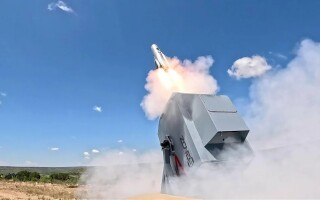The emerging era of intelligent deployed data storage
StorySeptember 09, 2024

System integrators seeking secure data-at-rest (DAR) solutions for deployed sensor-rich platforms are faced with handling increasing amounts of data from an ever-greater number of more powerful onboard sensors.
The need to capture and store the veritable firehose of incoming data, without introducing bottlenecks and losing data, is now being addressed with the availability of network-attached storage (NAS) devices that support data rates up to 100 Gigabit Ethernet. One beneficial trend for data storage is the advent of high-speed non-volatile memory (NVMe) solid-state memory devices that can keep up with the faster Ethernet. Additionally, NVMe devices are cost-effective and help reduce size, weight and power (SWaP), often a critical factor for extending the reach and duration of ISR [intelligence, surveillance, and reconnaissance] missions, many of which are deployed on uncrewed platforms.
Moore’s Law doesn’t just apply to processor performance – users of solid-state memory devices benefit from the increasing densities and affordability of rugged solid-state storage devices. Another important trend improving the capabilities of deployed NAS products is the use of two-layer encryption to protect the stored data, specifically the National Security Agency’s (NSA) Commercial Solutions for Classified (CSfC) program, which speeds the access to approved commercial off-the-shelf (COTS) data-protection technologies.
All of these converging trends are now driving the next major advance in data-storage solutions: the integration of built-in intelligence capable of processing and analyzing data during the mission. The usual way of handling data is that, after the sensor data is processed in real time by the mission computer, it is dealt with post-mission using removable storage media, usually delivered to a data center where it can be analyzed to identify patterns and signals of interest. Now, if the NAS features a cost-effective GPU processor with extreme parallel processing power, artificial intelligence/machine learning (AI/ML) and deep learning techniques can be developed to garner actionable information from the stored data on the platform during the mission.
GPU-enabled NAS systems deployed at the tactical edge can increase the precision of decision-making in applications such as predictive maintenance and logistic optimization, based on the analysis of the stored sensor and mission data well before that data can be physically delivered to the data center.
To leverage the possibilities of AI/ML, system integrators are now seeking GPU-enabled NAS solutions designed for use at the tactical edge. Work is now underway in lab settings to collect data and build models. To speed and help foster efforts to develop AI/ML models for analyzing DAR on-platform, system integrators need access to cost-effective GPU-enabled NAS solutions.
An example of a GPU-enabled 100GbE rugged secure DAR solution is Curtiss-Wright’s HSR100 Rackmount, a high-capacity NAS device packaged in a 1U rackmount form factor. It supports a pathway to NSA Type 1 or CSfC two-level encryption to provide secure DAR storage and recording, enabling near-line-rate recording capabilities supported with more than 64 TB of high-speed NVMe storage. Two 100 GbE ports are provided via QSFP56 interfaces and four 10 GbE ports via RJ45 and SFP+ interfaces. The NAS – intended for storing and protecting critical DAR on air, sea, and ground platforms – can be used in the lab or deployed at the tactical edge. It can also be housed in a 901D ruggedized enclosure for use in harsh environments. (Figure 1.)

[Figure 1 ǀ The HSR100 Rackmount 100 GbE secure data-at-rest storage and recording solution from Curtiss-Wright features deep learning support.]
Going forward, fully rugged modular open systems approach (MOSA)-based NAS variants, with increasingly high-performance GPUs based on an adaptable, flexible framework, will become widely available.
The secure storage of DAR is moving from the previous generation of passive, nonintelligent mass collection of raw data to an era of actionable data analysis that takes advantage of the converging trends of 100 GbE, NVMe memory, CSfC encryption, and GPU processing for deep learning. The emergence of intelligent data storage at the tactical edge is exciting, but equally compelling are the deployed applications that might emerge from GPU-enabled secure NAS systems. These upcoming applications will enable large amounts of data to be analyzed, patterns identified, and answers found, improving users’ ability to make better decisions faster and with more accuracy.
Steve Petric is senior product manager, Curtiss-Wright Defense Solutions.
Curtiss-Wright Defense Solutions https://www.curtisswrightds.com/







